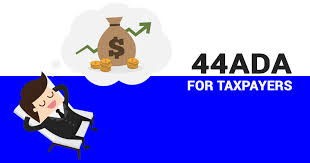Section 44ADA
The Presumptive Taxation Scheme under Section 44ADA of the Income Tax Act, 1961, was introduced to simplify the tax compliance process for small professionals and to reduce their tax burden. This scheme is specifically designed for individuals.
Hindu Undivided Families (HUFs), and partnership firms engaged in specified professions. It allows eligible taxpayers to declare their income on a presumptive basis, thus eliminating the need for detailed accounting.
Key Features of Section 44ADA
- Eligibility: The presumptive taxation scheme under Section 44ADA is applicable to professionals such as:
- Accountants
- Architects
- Engineers
- Medical professionals
- Lawyers
- Consultants
- Other professionals specified under Section 44AA(1) of the Income Tax Act
To be eligible, the total gross receipts of the professional must not exceed ₹50 lakhs in a financial year.
- Presumptive Income: Under this scheme, 50% of the total gross receipts are deemed to be the taxable income of the professional. For example, if a professional has gross receipts of ₹40 lakhs.
- The presumptive income will be ₹20 lakhs (50% of ₹40 lakhs).
- No Need for Detailed Books of Accounts: One of the significant advantages of this scheme is that eligible professionals are not required to maintain detail books of accounts. This simplifies the tax filing process, as taxpayers do not have to keep extensive records of their income and expenses.
- Tax Liability: The presumptive income calculate under this scheme is subject to income tax as per the applicable income tax slab rates. Professionals can also claim deductions under various sections, such as Section 80C for investments made in specified instruments.
- Tax Audit Exemption: Professionals opting for Section 44ADA are exempt from the requirement of tax audits, which can often be a cumbersome and time-consuming process.
- Filing Requirements: Professionals using this scheme must file their income tax returns under the ITR-4 form. It is essential to ensure that the gross receipts do not exceed the specified limit of ₹50 lakhs to qualify for the scheme.
- Transition to Other Taxation Regimes: If the gross receipts exceed ₹50 lakhs, the professional will have to transition to the regular taxation regime, where they will need to maintain detailed accounts and comply with the tax audit requirements.
Advantages of Section 44ADA
- Simplified Compliance: The scheme significantly reduces the compliance burden for small professionals, allowing them to focus more on their core activities rather than on complex accounting and tax filing processes.
- Reduced Tax Burden: By allowing professionals to declare 50% of their gross receipts as income, Section 44ADA helps in reducing the overall tax liability.
- Flexibility: The scheme provides flexibility for professionals to choose the presumptive taxation option without being bound by extensive regulations.
- Encouragement for Small Professionals: The introduction of this scheme aims to encourage more professionals to enter the formal tax system, ensuring better compliance and contributing to the nation’s tax revenues.
Disadvantages and Limitations
- Presumptive Income Limitation: Professionals may feel that 50% of gross receipts may not accurately reflect their actual income, especially if they have high expenses relate to their profession.
- Limit on Gross Receipts: The threshold of ₹50 lakhs may restrict larger professionals or firms from benefiting from this scheme.
- Ineligibility for Certain Deductions: While professionals can claim some deductions, the scheme does limit certain expenses that may be deductible under regular accounting practices.
FAQs:
For more information to Visit: https://www.incometax.gov.in
For further details access our website: https://vibrantfinserv.com

